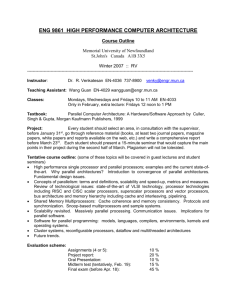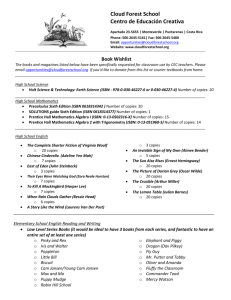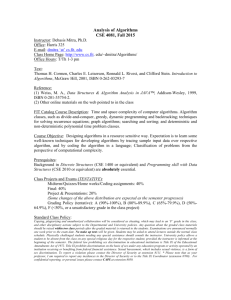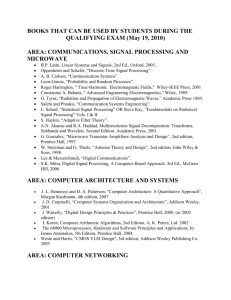CURRICULUM OF COMPUTER SCIENCE
advertisement
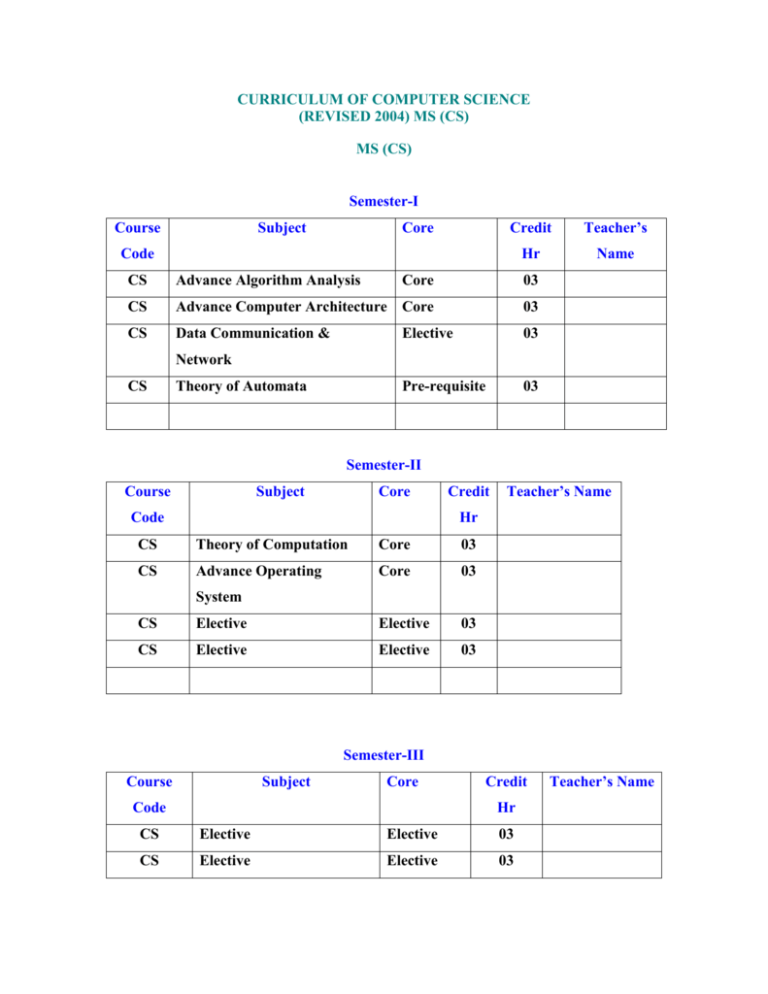
CURRICULUM OF COMPUTER SCIENCE (REVISED 2004) MS (CS) MS (CS) Semester-I Course Subject Core Credit Teacher’s Hr Name Code CS Advance Algorithm Analysis Core 03 CS Advance Computer Architecture Core 03 CS Data Communication & Elective 03 Pre-requisite 03 Network CS Theory of Automata Semester-II Course Subject Core Code Credit Teacher’s Name Hr CS Theory of Computation Core 03 CS Advance Operating Core 03 System CS Elective Elective 03 CS Elective Elective 03 Semester-III Course Subject Core Code Credit Hr CS Elective Elective 03 CS Elective Elective 03 Teacher’s Name Semester-IV Course Subject Core Credit Hr Code CS Teacher’s Name Thesis Total (all semesters) =30 06 Course Description and Profiles Core courses CS Theory of Computation Credit Hours: 3 Course Description: Automata theory, formal languages, Turing machines, computability theory and reducibility, computational complexity, determinism, non-determinism, time hierarchy, space hierarchy, NP completeness, selected advanced topics. Text Books/Reference Books: Michael Sipser, Introduction to the Theory of Computation, First Edition, 1997, PWS Publishing Company. Christos Papadimitriou, Computational Complexity, 1994, Addison-Wesley. John Hopcroft and Jeffrey Ullman, Introduction to Automata Theory, Languages, and Computation, 1979, Addison-Wesley. (or the second edition). Tao Jiang, Ming Li, and Bala Ravikumar, Formal models and Computability, in Handbook of Computer Science, CRC Press, 1996. T.H. Cormen, et al., Introduction to Algorithms, MIT Press and McGraw-Hill Book Co., 1990. Peter Linz, An Introduction to Formal Languages and Automata, ISBN: 0-669-17342-8 CS Advance Algorithm Analysis Credit Hours: 3 Course Description: Advanced algorithm analysis including the introduction of formal techniques and the underlying mathematical theory. NP completeness. Search Techniques. Randomized Algorithms. Heuristic and Approximation Algorithms. Topics include asymptotic analysis of upper and average complexity bounds using big-O, little-o, and theta notation. Fundamental algorithmic strategies (brute-force, greedy, divide-andconquer, backtracking, branch-and-bound, pattern matching, and numerical approximations) are covered. Also included are standard graph and tree algorithms. Additional topics include standard complexity classes, time and space tradeoffs in algorithms, using recurrence relations to analyze recursive algorithms, non-computable functions, the halting problem, and the implications of non-computability. Algorithmic animation is used to reinforce theoretical results. Upon completion of the course, students should be able to explain the mathematical concepts used in describing the complexity of an algorithm, and select and apply algorithms appropriate to a particular situation. Text Books/Reference Books: 1. Introduction to Algorithms, by T. Cormen, C. Leiserson, and R. Rivest. MIT Press and McGraw-Hill. 2. Computers and Intractability, Guide to the Theory of NP-Completeness, by M. Garey and D. Johnson. Computation, 1979, Addison-Wesley. (or the second edition). Tao Jiang, Ming Li, and Bala Ravikumar, Formal models and Computability, in Handbook of Computer Science, CRC Press, 1996. T.H. Cormen, et al., Introduction to Algorithms, MIT Press and McGraw-Hill Book Company, 1990. Peter Linz, An Introduction to Formal Languages and Automata, ISBN: 0-669-17342-8 CS Advanced Operating Systems Credit Hours: 3 The class covers advanced topics in computer operating systems with a special emphasis on distributed computing, and the services provided by distributed operating systems. Important topics include naming, security, remote procedure call, networks, concurrency, transactions, parallel computing, shared memory, message passing, and scale. Text Books/Reference Books: Distributed Systems: Concepts and Design by Coulouris, Dollimore, and Kindberg, 3rd Edition. CS Advanced Computer Architecture Credit Hours: 3 Course Description: Design and evaluation of modern uniprocessor computing systems. Evaluation methodology/metrics and caveats, instruction set design, advanced pipelining, instruction level parallelism, prediction-based techniques, alternative architectures (VLIW, Vector and SIMD), memory hierarchy design and I/O. Case studies. Text Books/Reference Books: John L. Hennessy and David A. Patterson, Computer Architecture: A Quantitative Approach, 3rd Edition, Morgan Kaufmann Publishers, 2002. Andrew S. Tanenbaum, Modern Operating Systems, 2nd Edition, Prentice Hall, 2001. John Hennessy and David Patterson, Computer Organization and Design: The Hardware/Software Interface, 2nd Edition, Morgan Kaufman Publishers Selected Electives courses: CS Digital Signal Processing Credit Hours: 3 Course Description: One- and N-dimensional signals and systems, Sampling theorem, Discrete-time Fourier transform, discrete Fourier transform, fast Fourier transform, z-transforms: stability and minimum phase signals/systems, Linear filtering of signal: Time domain: Difference equations and convolution, Impulse invariance, bilinear transform, FIR filter design, 2D filter design, Statistical signal processing: Stochastic signals: correlation functions and power density spectra, Optimal filtering: Wiener filters, Adaptive filters: LMS and array processing. Text Books/Reference Books: Discrete-Time Signal Processing, 2nd edition Alan V. Oppenheim and Ronald W.71 Schafer, Prentice-Hall. CS Parallel and Distributed Computing: Credit Hours: 3 Course Description: Why use parallel and distributed systems? Why not use them? Speedup and Amdahl's Law, Hardware architectures: multiprocessors (shared memory), networks of workstations (distributed memory), clusters (latest variation). Software architectures: threads and shared memory, processes and message passing, distributed shared memory (DSM), distributed shared data (DSD). Possible research and project topics, Parallel Algorithms, Concurrency and synchronization, Data and work partitioning, Common parallelization strategies, Granularity, Load balancing, Examples: parallel search, parallel sorting, etc. Shared-Memory Programming: Threads, Pthreads, Locks and semaphores, Distributed-Memory Programming: Message Passing, MPI, PVM. Other Parallel Programming Systems, Distributed shared memory, Aurora: Scoped behaviour and abstract data types, Enterprise: Process templates. Research Topics Text Books/Reference Books: B. Wilkinson and M. Allen, Parallel Programming: Techniques and Applications Using Networked Workstations and Parallel Computers, 1/e, Prentice Hall, 1999. W. Stevens, Advanced Programming in the Unix Environment, Addison Wesley, 1993. CS Control Systems and Robotics: Credit Hours: 3 Course Description: Review of classical control analysis methods. Nyquist stability criterion. Classical design using frequency domain methods, phase lead and lag controllers, PID controllers. Relay auto tuning. Introduction to state space methods. State space models, state transformations, solution of the state equations. Controllability and observability. Design using state feedback. LQR design, pole placement, use of observers. Introduction to robotics. Transducers, actuators and robot control. Text Books/Reference Books: R.C. Dorf, Modern Control Systems, 7th (1995), 8th (1998) or 9th (2001) Edition, Addison-Wesley. C.C. Bissell, Control Engineering, 2nd Edition, 1994, Publisher: Chapman &Hall. K.Ogata, Modern Control Engineering, Prentice Hall, 2nd ed. 1990. CS Real Time Operating Systems Credit Hours: 3 Course Description: The principles of real-time and embedded systems inherent in many hardware platforms and applications being developed for engineering and science as well as for ubiquitous systems, including robotics and manufacturing, interactive and multimedia, immersive and omnipresent applications. Real-time and quality of service system principles, understand realtime operating systems and the resource management and quality of service issues that arise, and construct sample applications on representative platforms. Platforms range from handheld and mobile computers to media and real-time server systems. Platforms may also include specialized systems used in application-specific contexts, such as autonomous robotics, smart sensors, and others. Text Books/Reference Books: It is an advanced course and the instructor may make his notes from various resources at the web. CS Advanced Networking: Credit Hours: 3 Course Description: Review of basic concepts: The OSI Model, packet and circuit switching, network topology, ISDN. The TCP/IP protocol stack: IP, ARP, TCP and UDP, DNS, ICMP, Internet Addressing, Routing, IP Multicast, RSVP, Next Generation IP – Ipng, Wireless: Radio basics, Satellite Systems, WAP, current trends, Issues with wireless over TCP. Congestion Control: Control vs. Avoidance. Algorithms, Congestion in the Internet. Mobile IP, Voice over IP (VoIP), VPNs, Network Security. Management: Quality of Service (QoS), network vs. distributed systems management Protocols, web-based management Text Books/Reference Books: James F. Kurose and Keith W. Ross, “Computer Networking – A Top-Down Approach Featuring the Internet”, Addison Wesley. Coulouris, Dollimore, Kindberg, “Distributed Systems – Concepts and Design”, Addison Wesley. William Stallings, "Data and Computer Communications", Prentice-Hall — Sixth Edition (for those who want to review basics of networking). CS Network Security: Credit Hours: 3 Course Description: Introduction; Cryptology and simple cryptosystems; Conventional encryption techniques; Stream and block ciphers; DES; More on Block Ciphers; The Advanced Encryption Standard. Confidentiality & Message authentication: Hash functions; Number theory and algorithm complexity; Public key Encryption. RSA and Discrete Logarithms; Elliptic curves; Digital signatures. Key management schemes; Identification schemes; Dial-up security. E-mail security, PGP, S-MIME; Kerberos and directory authentication. Emerging Internet security standards; SET; SSL and IPsec; VPNs; Firewalls; Viruses; Miscellaneous topics. Text Books/Reference Books: W. Stallings, Cryptography and Network Security, Prentice Hall PTR, Upper Saddle River, NJ, 2003. C. Kaufman, R. Perlman, M. Speciner, Network Security: Private Communication in a Public World – Prentice Hall PTR, Upper Saddle River, NJ, 2002. M. Bishop, Computer Security: Art and Science – Addison-Wesley, 2003. D. Stinson, Cryptography: Theory and Practice, CRC Press, Boca Raton, FL, 1995. Richard A. Mollin, An Introduction to Cryptography, Chapman and Hall/CRC, 2001. B. Schneier, Applied Cryptography, John Wiley and Sons, NY, 1996. A. Menezes, P. Oorshcot, and S. Vanstone, Handbook of Applied Cryptography, CRC Press, Boca Raton, FL, 1997. CS Topics in Computer Networking: Credit Hours: 3 Course Description: This course offers an advanced introduction and research perspectives in the areas of switch/router architectures, scheduling for besteffort and guaranteed services, QoS mechanisms and architectures, web protocols and applications, network interface design, optical networking, and network economics. The course also includes a research project in computer networking involving literature survey, critical analysis, and finally, an original and novel research contribution. Typical topics can be listed below: Overview of packet switching networks and devices. Fundamentals of Internet Protocol (IP) networking. Route lookup algorithms. Router architecture and performance. Detailed operation of Internet routing protocols such as Open Shortest Path First (OSPF) and Border Gateway Protocol (BGP). Integrated and differentiated network service models. Traffic Engineering (TE) concepts and mechanisms including label assignment, label distribution, and constraintbased routing algorithms. Multi-protocol label switching and its generalization. Quality of service mechanisms for multimedia and real-time communications. TE-based routing and signalling protocols. Fundamentals of per-flow and aggregate scheduling algorithms. Application-level and network-level signaling protocols for data, voice, and video communications. Resource signalling and resource reservation protocols. Worst-case analysis for multimedia networking. Text Books/Reference Books: Puzmanov, Switching and Routing, Addison Wesley, 2002. Garica and Widjaja, Communication Networks: Fundamentals Concepts and Key Architectures, McGraw-Hill, 2001. Peterson and Davie, Computer Networking a Systems Approach, 3rd Edition, Morgan Kaufman, 2003. William Stallings, High-Speed Networks: TCP/IP and ATM Design Principles, Prentice Hall; 1998, ISBN: 0135259657. Andrew S. Tanenbaum, Computer Networks, 3rd Edition. Prentice Hall, March 1996. CS Network Administration Credit Hours: 3 Course Description: Through completion of this course, students will be able to plan, install, and configure a Web Server, manage, monitor, and optimize a Web Server, and design and implement a Web Site on the Web Server created.74 Text Books/Reference Books: Information Technology Project Management. (2002) Course Technology. ISBN: 0619035288. Principles of Web Design. (2000) Course Technology. ISBN: 0-619-01526- CS Wireless Networks: Credit Hours: 3 Course Description: This course covers fundamental techniques in design and operation of first, second, and third generation wireless networks: cellular systems, medium access techniques, radio propagation models, error control techniques, handoff, power control, common air protocols (AMPS, IS-95, IS- 136, GSM, GPRS, EDGE, WCDMA, cdma2000, etc), radio resource and network management. As an example for the third generation air interfaces, WCDMA is discussed in detail since it is expected to have a large impact on future wireless networks. This course is intended for graduate students who have some background on computer networks. Text Books/Reference Books: W. Stallings, “Wireless Communications and Networks”, Prentice Hall, 2002. T.S. Rappaport, “Wireless Communications: Principles & Practice”, Second Edition, Prentice Hall, 2002. J. Schiller, “Mobile Communications”, Addison Wesley, 2000. V.K. Garg, “IS-95 CDMA and cdma 2000”, Prentice Hall PTR, 2000. J.P. Castro, “The UMTS Network and Radio Access Technology - Air Interface Techniques for Future Mobile Systems”, Wiley, 2001. H. Holma and A. Toskala, “WCDMA for UMTS Radio Access for Third Generation Mobile Communications”, John Wiley & Sons, 2001. CS Network Performance Evaluation: Credit Hours: 3 Course Description: This is an advanced course in networks and protocols. Analytical, simulation and experimental methods should be used to evaluate and design networks and protocols. Investigate network management tools and techniques. Text Books/Reference Books: T. G. Robertazzi, Computer Networks and Systems: Queuing Theory and Performance Evaluation, Springer-Verlag, 2nd edition, 1994. CS Theory of Programming Languages: Credit Hours: 3 Course Description: Introduction and History, Syntax and Semantics, Control Structures, Types, Logic Programming, Functional Programming and Lambda calculus, Concurrent and Distributed Programming, Dataflow, Object-oriented Programming. Text Books/Reference Books: Raphael Finkel, Advanced Programming Language Design, Addison-Wesley. ISBN: 0805311912 Introduction to the Theory of Programming Languages -- Bertrand Meyer The Study of Programming Languages -- Ryan Stansifer. The Anatomy of Programming Languages -- Fischer and Grodzinsky Concepts of Programming Languages – Sebesta CS ADVANCED Compiler Design I: Credit Hours: 3 Course Description: An in-depth study of compiler backend design for high performance architectures. Topics include control-flow and data-flow analysis, classical optimization, instruction scheduling, and register allocation. Advanced topics include memory hierarchy management, optimization for instruction-level parallelism, modulo scheduling, predicated and speculative execution. The class focus is processor-specific compilation techniques, thus familiarity with both computer architecture and compilers is recommended. Text Books/Reference Books: Compilers: Principles, Techniques, and Tools, Alfred V. Aho, Ravi Sethi, and Jeffrey D. Ullman, Addison-Wesley, 1988. Advanced Compiler Design & Implementation, Steven S. Muchnick, Morgan Kaufmann, 1997. Building an Optimizing Compiler, Robert Morgan, Butterworth-Heinemann, 1998. CS Advanced Compiler Design II: Credit Hours: 3 Course Description: The course should consist of one or two major projects. Theoretical study should depend on the level of the first course Design I and the student needs. Text Books: Compilers: Principles, Techniques, and Tools, Alfred V. Aho, Ravi Sethi, and Jeffrey D. Ullman, Addison-Wesley, 1988. Advanced Compiler Design & Implementation, Steven S. Muchnick, Morgan Kaufmann, 1997. Building an Optimizing Compiler, Robert Morgan, Butterworth-Heinemann, 1998. CS Intelligent User Interfaces: Credit Hours: 3 Course Description: The increasing complexity of software and the proliferation of information makes intelligent user interfaces increasingly important. The promise of interfaces that are knowledgeable, senstitive to our needs, agile, and genuinely useful has motivated research across the world to advance the state of the art and practice in user interfaces that exhibit intelligence. The text covers the topic well. Text Books: Readings in Intelligent User Interfaces, Mark T. Maybury (Editor), Wolfgang Wahlster (Editor), Paperback - 736 pages (April 1998) Morgan Kaufman Publishers; ISBN: 1558604448.76 CS Multimedia Database: Credit Hours: 3 Course Description: Introduction; Overview of Relational and Object-Relational Data Representations; Text/Document Databases; Multidimensional Data Structures, similarity based search (spatial, image, audio); XML Databases; Temporal Data Models; Logical Frameworks. Text Books/Reference Books: Principles of Multimedia Database Systems, by V.S. Subrahmanian, Morgan Kaufmann Publishing Company, San Fransisco, CA. 1998. ISBN: 1558604669. Principles of Database Query Processing for Advanced Applications (Morgan Kaufmann Series in Data Management Systems), by Clement T. Yu, Weiyi Meng, 1998. ISBN: 1558604340. Databases and Transaction Processing, An Application-Oriented Approach, Philip M. Lewis, Arthur Bernstein, and Micheal Kifer. Addison Wesley Publishers, 2002. ISBN: 0201708728. CS Rich Internet Applications Credit Hours: 3 Course Description: This course covers the concept and technology evolution regarding the internet applications and the use of interface tools. Mainly, the course can focus on any one of the technologies of modern day, for example, macromedia’s FLASH. However, the course will use the concepts of data structures, object oriented programming, programming languages and the software design and engineering to develop projects of medium to large magnitude. Text Books/Reference Books: No particular text book can be specified as the contents and teaching approach depend on the instructor and the latest trends in the area. Macromedia’s presence on the web can be utilized to maximum, however.

